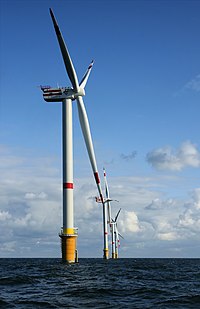
Photo from wikipedia
Abstract Wind-lens turbines offer the potential for better energy efficiency and better suitability for urban and suburban environments compared to unshrouded or bare wind turbines. Wind-lenses, which are typically comprised… Click to show full abstract
Abstract Wind-lens turbines offer the potential for better energy efficiency and better suitability for urban and suburban environments compared to unshrouded or bare wind turbines. Wind-lenses, which are typically comprised of a diffuser shroud equipped with a flange, can enhance the wind velocity at the rotor plane due to the generation of a lower back pressure. In this article, the wind-lens efficiency is increased by designing the shroud and turbine shape as well as flange height through an optimization process that seeks to maximize the power while minimizing drag and thrust forces. The employed optimizer is a multi-objective genetic algorithm (MOGA). Bezier curves are used to define the chord and twist distribution of the turbine blades and a piece-wise quadratic polynomial is utilized to define the shroud shape. The power, thrust, and drag coefficients are calculated by solving the Reynolds-averaged-Navier-Stokes (RANS) equations with the k − e turbulence model for the flow within and around the diffuser augmented wind turbine using the open source code software OpenFOAM. To reduce the computational cost, the turbine rotor itself is modeled by incorporating blade element momentum model body forces into the RANS equations. Realistic rotor data for the sectional lift and drag coefficients for all angles of attacks are utilized via look-up tables. Grid convergence studies for verification and comparisons with experiments for validation are carried out to demonstrate that the adopted methodology is able to accurately predict the performance of a wind-lens prior to performing shape optimizations. It will be demonstrated that the resulting optimal designs yield significant improvements in the output power coefficient.
Journal Title: Energy
Year Published: 2018
Link to full text (if available)
Share on Social Media: Sign Up to like & get
recommendations!